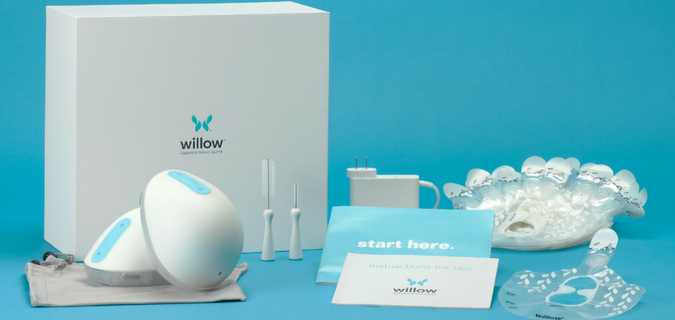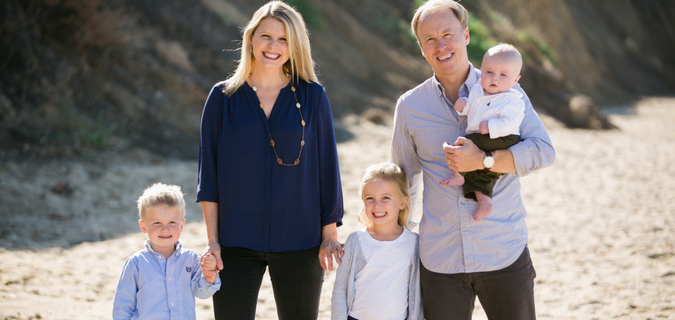- Undergraduate
Bachelor's Degrees
Bachelor of ArtsBachelor of EngineeringDual-Degree ProgramUndergraduate AdmissionsUndergraduate Experience
- Graduate
Graduate Experience
- Research
- Entrepreneurship
- Community
- About
-
Search
All Thayer News
Alumni Portrait: Brian Mason '03 Th'04 Th'05
Feb 18, 2019 | by Kristen Senz
Product Designer
Brian Mason '03 Th'04 '05, wife Jocelyn Mason '05, and children
With an invention portfolio that includes a ski pole that doubles as a lock and a bicycle that filters drinking water, Brian Mason ’03 Th’04 ’05 wasn’t sure how people would react to his latest project – a revolutionary new breast pump.
But Mason, a father of three, says his friends and family are cheering him on. “People have been through it,” he says. “They’ve seen the struggles, so they get it, and a lot of people are really excited to see innovation in this space.”
That innovation is the Willow Pump, a wearable breast pump poised to revolutionize an industry and relieve thousands of new moms from dangling tubes and noisy machines. Now available broadly, it was just named one of Time magazine’s top 25 innovations of 2017.
“There’s this huge craze around wearables, and a lot of them are me-too products, but this one is not,” says Mason. “We started from the ground up to redesign the breast pump.”
Having spent nearly a decade at the innovation and design firm IDEO — leading creative teams developing everything from medical devices to playground equipment – Mason envisioned happily making his whole career there. But when Willow approached IDEO to help with the industrial design of the pump, he saw the potential to be part of a product squarely at the intersection of the medical device and consumer markets.
In early 2015, Mason made the tough choice to leave IDEO. He became director of research and development for Willow Pump, a start-up company spun out of the Silicon Valley-based incubator ExploraMed. Over the next two years, Mason and the small team at Willow Pump developed the prototype – “a black box with Radio Shack parts,” explains Mason – into a simple, quiet, all-in-one pump and spill-proof bag that can be worn inside a bra.
Along the way, Mason sought frequent feedback from his wife, Jocelyn Mason ’05, friends, and family, among other mom testers, on the pump’s design and features. Last summer, when the Willow Pump was about to go on the market, Jocelyn was in the third trimester of her pregnancy with the couple’s third child, Andrew. Which would debut first?
“Andrew ended up being born about a week before our official launch, and my wife got to use the pump soon after,” says Mason. “It’s been a fun journey for both of us, and it’s something she knows is deeply impactful and valuable. She’s been an inspiration for me since day one.”

Willow Pump - a wearable breast pump
Picking a Path
A Connecticut native, Mason, like most engineers, grew up building and taking things apart, often in the workshop with his father, whom he strives to emulate in many areas of life. But he was also drawn early on to the health care field; his mother and sister are both nurses, and he lists them among his heroes. Mason says he might’ve ended up becoming an orthopedic surgeon, were it not for one problem: “I pass out at the sight of blood.”
Instead, he set his sights on engineering. Initially unsure where to focus his studies, he gravitated toward hands-on courses at Thayer. During a class demonstration by Professor Peter Robbie, Mason discovered product design. “It was like a lightbulb went off, and I thought, ‘Wow, those kinds of jobs are available?’”
At Thayer, Mason also learned about IDEO, where an internship turned into a full-time job. With an emphasis on iteration, empathy, and communication, Mason found success and forward momentum. He says he owes that, in part, to the liberal arts bent of his Thayer undergraduate and graduate education.
“A huge part of designing good products is getting out into the world, talking to people, getting their feedback, and not sitting in a bubble (or your cubicle), thinking you know or have the answer. Communicating and collaborating are so important… Being an engineer, I think I would give a lot of credit to a liberal arts education, because I know it’s not just about that great thing we built, but whether we paid attention to all the little details, the feedback we received, and in the end, met the user’s needs.”
Mason says he also particularly enjoys working directly with suppliers – he has made about 10 trips to Asia over the past couple of years – on the process of manufacturing and scaling at high volume. After tackling the complexities and ambiguity involved in design, shifting to a process with clearly defined goals can be refreshing, he says.
Beyond successfully bringing innovative products to market, Mason is driven by his early recognition of “the need to serve outside yourself.” Learned through his upbringing and participation in Christian communities, both while growing up and at Dartmouth, this core value has manifested in Mason’s engineering work and seems likely to benefit new moms for generations to come.
As Mason puts it, “In the areas of life where I’m spending the most time and energy – at home with my family and my friends, and then at work – I want them both to have impacts that are beyond me.”
For contacts and other media information visit our Media Resources page.

